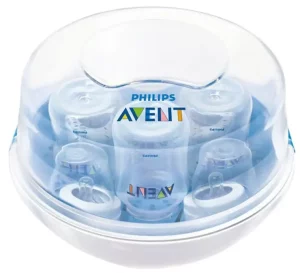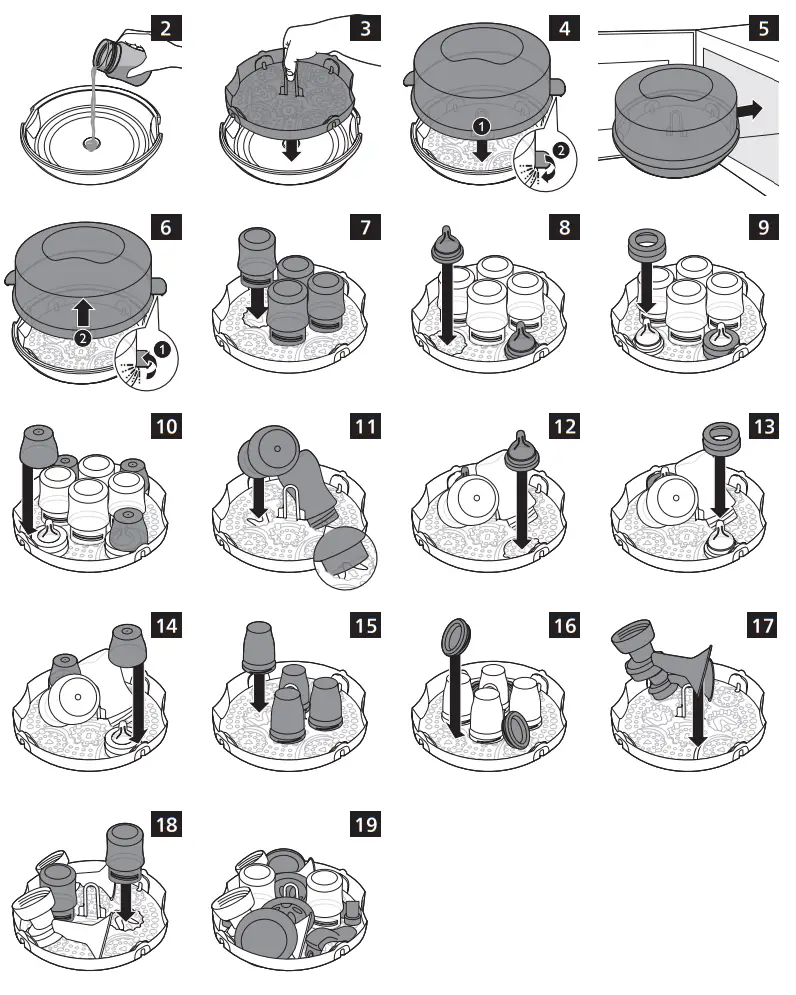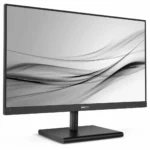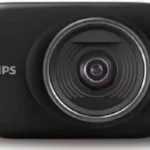

AVENT
SCF283, SCF282, SCF281


Introduction
Congratulations on your purchase and welcome to Philips! To fully benefit from the support that Philips offers, register your product at www.philips.com/welcome.
General description (Fig. 1)
- Lid
- Clips
- Basket
- Base
- Bottle cavities
- Teat cavities
- Dome cap holders
- Slots for large bottles
- Slots for breast pumps
Important
Read this user manual carefully before you use the microwave sterilizer and save it for future reference.
Warning
– Let the sterilizer cool down before you remove it from the microwave. Be careful when you move or open the sterilizer because the water in it can still be hot.
– Do not remove the lid from the sterilizer immediately after sterilizing, as the steam that comes out is very hot. Let the sterilizer cool down, as steam can cause burns.
– Only use water without any additives.
– Always make sure that the base is filled with water when you use the sterilizer in the microwave.
– Do not put bleach or other chemicals in the sterilizer.
– Do not place metal items in the sterilizer, as this may cause damage to the microwave.
– Do not overload the sterilizer, otherwise, the items are not sterilized properly.
– Only sterilize baby bottles and other items that are suitable for sterilizers. Check the user manual of the items you want to sterilize, to make sure they are suitable for sterilizers.
– This sterilizer is intended for household use only.
Caution
– Children should be supervised to ensure that they do not play with the sterilizer.
– Always make sure the base is filled with 200ml water before you start sterilizing.
– After each use, pour any remaining water out of the sterilizer after the water has cooled down.
– Always let the sterilizer cool down before you store it.
– Always wash your hands before you touch the sterilized items.
– Do not expose the sterilizer to extreme heat or direct sunlight.
– Do not place the sterilizer on a hot surface.
– If you use a combination oven (with grill function), make sure that the oven or grill is switched off and has cooled down before you put the sterilizer in it.
Before first use
Before you use the sterilizer for the first time, clean it thoroughly as described below.
- Remove the basket from the base.
- Fill a baby bottle or a measuring cup with exactly 200ml tap water and pour this into the base (Fig. 2).
The amount of water needs to be exactly 200ml. When the base contains too much water, the items will not be sterilized properly. When the base does not contain enough water, this can cause damage to the sterilizer or microwave. - Place the basket in the base (Fig. 3).
- Put the lid on the sterilizer (1) and push down the clips to lock the lid into place (2). (Fig. 4)
- Place the sterilizer in the microwave. (Fig. 5)
Note: Make sure that the microwave is clean and dry before you start sterilizing.
Note: If you have a combination oven, make sure that the oven or grill is switched off and has cooled down before you put the sterilizer in it. - Select the appropriate microwave wattage and time (see the table in the chapter ‘Using the microwave sterilizer’) and let the microwave operate.
- After the microwave has finished, open it and let the sterilizer cool down before you remove it from the microwave.
- Pull open the clips (1) and remove the lid (2) (Fig. 6).
- Pour out the remaining water and rinse the base and basket thoroughly.
Preparing for use
Filling the basket
Before you put the items to be sterilized in the basket, clean them thoroughly in the dishwasher or clean them by hand with hot water and some washing-up liquid. Make sure you remove all milk residues.
Note: Make sure all items to be sterilized are completely disassembled and place them in the basket with their openings pointing downwards, to prevent them from filling with water.
Note: Do not stack the items too closely together. The steam has to be able to circulate around the items to ensure effective sterilization.
There are several ways to fill the basket:
Four Philips AVENT feeding bottles
- Place the bottles upside down in the bottle cavities. (Fig. 7)
- Place the treats in the teat cavities (Fig. 8).
- Place the screw rings loosely on top of the teats (Fig. 9).
Note: Larger screw rings only fit if placed in a slanted position over the teats. - Place the dome caps in the dome cap holders (Fig. 10).
Two large Philips AVENT feeding bottles (330ml/11oz)
- Insert the rim of the bottles into the slots for large bottles (Fig. 11).
- Place the treats in the teat cavities (Fig. 12).
- Place the screw rings loosely on top of the teats (Fig. 13).
Note: Larger screw rings only fit if placed in a slanted position over the teats.
- Place the dome caps in the dome cap holders (Fig. 14).
Four Philips AVENT storage cups and lids
- Place the storage cups upside down in the basket (Fig. 15).
- Place the lids vertically around the bottles. (Fig. 16)
Two Philips AVENT breast pumps and two Philips AVENT feeding bottles
Do not place the electrical parts in the sterilizer.
- Fully disassemble the breast pump.
- Insert the rim of the pump body in the breast pump slots at the bottom of the basket (Fig. 17).
- Place the bottles upside down in the bottle cavities (Fig. 18).
- Place the remaining non-electrical parts of the breast pump in any unobstructed space in the basket (Fig. 19).
Note: Make sure steam can circulate around these parts.
Using the microwave sterilizer
Only place items in the sterilizer that are suitable for sterilizing. Do not sterilize your bottle brush or items that are filled with liquid, e.g. teethers filled with cooling fluid.
Note: Before you sterilize bottles and other items, clean them first.
- Remove the basket from the base.
- Fill a baby bottle or measuring cup with exactly 200ml tap water and pour this into the base (Fig. 2).
The amount of water needs to be exactly 200ml. When the base contains too much water, the items will not be sterilized properly. When the base does not contain enough water, this can cause damage to the sterilizer or microwave. - Place the basket in the base (Fig. 3).
- Place the items to be sterilized in the basket (see chapter ‘Preparing for use’).
- Put the lid on the sterilizer (1) and push down the clips to lock the lid into place (2) (Fig. 4).
- Place the sterilizer in the microwave. (Fig. 5)
Note: Make sure that the microwave is clean and dry before you start sterilizing. - Select the appropriate microwave wattage and time (see table below) and let the microwave operate.
Note: If you have a combination oven, make sure that the oven or grill is switched off and has cooled down before you put the sterilizer in it.
Note: Do not exceed the sterilizing time indicated in the table.
Microwave specificationsWattage Sterilizing time Cool-down time 1200W-1850W 2min. 2min. 850W-1100W 4min. 2min. 500W-800W 6min. 2min. - After the microwave has finished, open it and let the sterilizer cool down before you remove it from the microwave. Be careful, hot steam may come out of the microwave.
- Remove the sterilizer from the microwave.
Note: Make sure you keep the sterilizer level to avoid leaking or spilling hot water.
Note: The sterilized items remain sterile for up to 24 hours in the microwave sterilizer if you do not remove the lid. - Pull open the clips (1) and remove the lid (2) (Fig. 6).
- Remove the bottles and other items from the basket. Use the tongs to remove the smaller items.
Be careful, hot steam may come out of the sterilizer and the sterilized items may still be hot. - When you have removed the sterilized items, pour out the remaining water, rinse the base and basket thoroughly and wipe all parts dry.
Cleaning
Clean the lid, the basket, and the base after every use, to prevent scale from building up.
Never use scouring pads, abrasive cleaning agents, or aggressive liquids such as bleach, petrol, or acetone to clean the sterilizer.
Note: Let the sterilizer cool down before you clean it.
- Clean the sterilizer parts in hot water with some washing-up liquid.
Note: You can also clean the sterilizer parts in the dishwasher. - After cleaning, dry all parts properly.
Note: After cleaning, store the sterilizer in a clean, dry place.
Guarantee and service
If you need service or information or if you have a problem, please visit the Philips website at www.philips.com or contact the Philips Consumer Care Centre in your country (you find its phone number in the worldwide guarantee leaflet). If there is no Consumer Care Centre in your country, go to your local Philips dealer.
© 2021 Koninklijke Philips N.V.
All rights reserved.
22/12/2021



